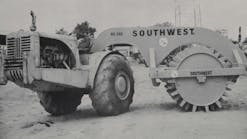Several widely used construction machines were originally developed for agriculture. The crawler tractor, skid-steer loader, and backhoe loader, were all first designed for farming applications, and over time were improved upon and accepted within numerous other industries.
Loader attachments for both wheel and crawler tractors date to the late 1920s, but a backhoe attachment took longer. Backhoes of that time (and, for that matter, those early loaders) were operated by cables, and there was no realistic way of mounting a backhoe onto a tractor because of the machinery needed to operate the boom and bucket. Maine Steel Works made a go of it with a small cable backhoe attachment for Cletrac crawler tractors; but while it could dig trench, it had no swing capability; to move the bucket clear of the trench for dumping, the entire tractor had to be turned.
It wasn’t until hydraulic technology had developed enough to be useful for construction machinery that a tractor-mounted backhoe became practical. The principle was there, but it wasn’t until after World War II that enough power could be generated from cylinders of suitable size for tractor mounting.
The idea developed separately in the United States and Great Britain. The earliest documented hydraulic backhoe was built in the U.S. by Vaino J. Holopainen and Roy E. Handy Jr. in 1947, and it became the foundational product of Wain-Roy Corp. In England, the Whitlock Brothers experimented with a backhoe attachment in 1951 and added a loader in 1952.
These devices had a common theme: They were built by companies entirely separate from the manufacturers of the tractors for which they were designed. Some companies offered both loader and backhoe attachments, but it wasn’t unusual to have a tractor built by one manufacturer outfitted with a loader from a second and a backhoe from a third. Some of these machines were equipped with a backfill blade and backhoe combination. At any rate, the tractor dealer usually also sold a line or two of loader and backhoe attachments—but not all, and each manufacturer had its own warranty coverage.
Although these machines were certainly versatile, even before the introduction of all sorts of attachments for them, their usefulness was limited. They did fine in agricultural and light service, but—to borrow a phrase from the 1920s—they couldn’t stand the gaff of construction and other heavy industrial applications.
Along with the tractor-mounted backhoes, Badger Machine Co. and others developed backhoes to be pulled behind and powered by the tractor. Badger called its machine the Hopto, an acronym for Hydraulic Operated Power Take Off, and the name was continued on a line of crawler- and truck-mounted hydraulic excavators.
Finally, in the late 1950s Case (in America) and JCB (in England) began offering purpose-built, heavy-duty wheel tractors and the loaders and backhoes to go on them. This put the entire machine under the coverage of a single warranty, and gave rise to their widespread use in construction.
As a footnote, hydraulic backhoe attachments have also been offered for small to midsize crawler tractors and loaders. Most were set up like their rubber-tired counterparts, but one, the Tractomotive Trench Hoe for the Allis-Chalmers HD5 crawler tractor, was a throwback to that cable backhoe for the Cletrac: Although it was hydraulically operated, it too had no swing mechanism.
The Historical Construction Equipment Association (HCEA) is a 501(c)3 non-profit organization dedicated to preserving the history of the construction, dredging and surface mining equipment industries. With over 3,800 members in 25 countries, our activities include publication of a quarterly educational magazine, Equipment Echoes, from which this article is adapted; operation of National Construction Equipment Museum and archives in Bowling Green, Ohio; and hosting an annual working exhibition of restored construction equipment. Information is available at www.hcea.net, or by calling 419.352.5616 or emailing i[email protected].





